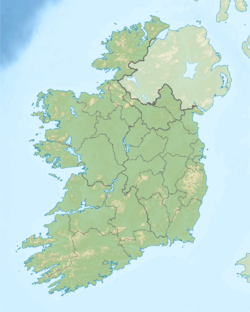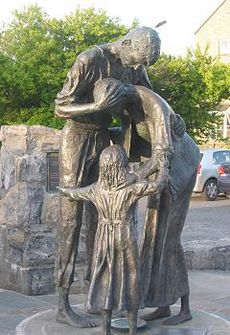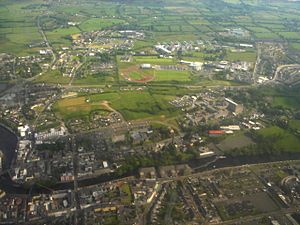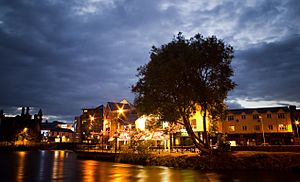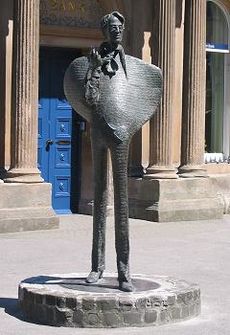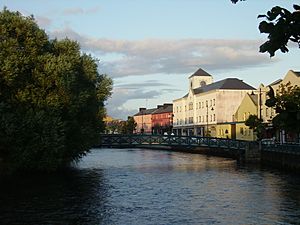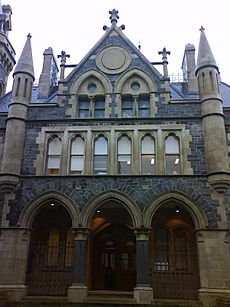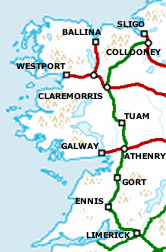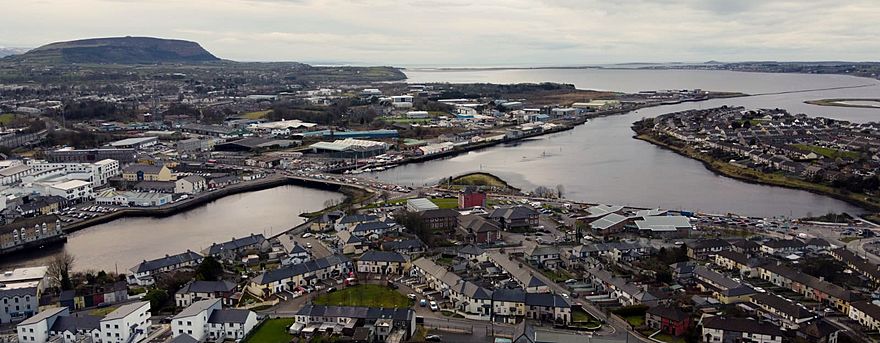Sligo facts for kids
Quick facts for kids
Sligo
Sligeach
|
|
|---|---|
|
Town
|
|
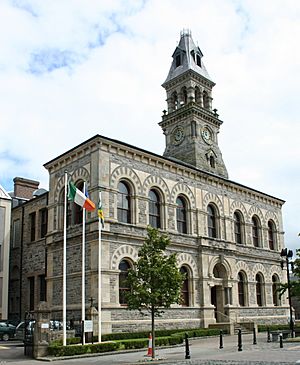
Sligo Town Hall
|
|
| Country | Ireland |
| Province | Connacht |
| County | County Sligo |
| Barony | Carbury |
| Dáil constituency | Sligo–Leitrim |
| EU Parliament | Midlands–North-West |
| Area | |
| • Total | 10.3 km2 (4.0 sq mi) |
| Elevation | 13 m (43 ft) |
| Population
(2022)
|
|
| • Total | 20,608 |
| • Density | 2,001/km2 (5,182/sq mi) |
| Eircode (Postcode) District |
F91
|
| Irish Grid Reference | G685354 |
| Dialing code | +353 71 |
Sligo (pronounced SLY-goh) is a lively coastal town in County Sligo, Ireland. It's the main town of the county and is located in the western part of Ireland called Connacht. In 2022, about 20,608 people lived here, making it the biggest town in County Sligo.
Sligo is a busy place for business and culture on Ireland's west coast. Many people visit Sligo because of its beautiful coast and countryside. It's also famous for its connections to the well-known poet W. B. Yeats.
Contents
Exploring Sligo's Past
What's in a Name? The Meaning of Sligo
The name Sligo comes from the Irish word Sligeach. This means "full of shells" or "shelly place." It got this name because there were lots of shellfish in the river and its mouth. People also found many old shell piles nearby. The river, now called the Garavogue, was once known as the Sligeach. It was even mentioned as one of Ireland's "royal rivers" long ago.
Old records from 1836 say that "cart loads of shells were found underground" in the town. This shows how important the sea was to the people living here, even thousands of years ago.
Sligo's Ancient Beginnings
Sligo has been an important place for a very long time. There are many ancient sites near and even inside the town. For example, Sligo's first roundabout was built around an old passage tomb. This is a type of ancient burial place made of large stones.
The area around Sligo has one of the highest numbers of prehistoric sites in Ireland. You can find all kinds of ancient stone monuments here. Knocknarea mountain, with its large stone cairn (a pile of stones) called Miosgan Maeve, stands tall to the west. Cairns Hill, on the south side of town, also has two huge stone cairns.
In 2002, archaeologists found a very old causewayed enclosure at Magheraboy. It was built around 4000 B.C. This is the oldest one found in Britain or Ireland! It was a large area with a ditch and fence, possibly used for trade or special ceremonies. These sites show when farming first came to Ireland.
Sligo Bay has always been a natural harbor. Ancient traders from Greece, Phoenicia, and Rome might have known it. Some even think it's the city of Nagnata shown on an old map from the 2nd century A.D. By the 12th century, a small settlement and a bridge existed where Sligo town is today.
Medieval Sligo: Castles and Clans
A Norman knight named Maurice Fitzgerald helped build the town and port of Sligo. He built Sligo Castle in 1245. A Dominican Friary (a type of monastery) was also started in 1253. It burned down in 1414 but was rebuilt.
The Normans didn't control Sligo for long. By 1315, native Irish families, especially the O'Conor Sligo clan, took over. Sligo became the main center for this group of Irish territories. The town grew, trading with places like Galway, Bristol, France, and Spain.
Sligo was attacked or burned about 49 times during the medieval period. This was due to different Irish families fighting for control of the busy port. But these attacks didn't stop the town from growing. Sligo remained under Irish control until the late 1500s. Then, during the Elizabethan conquest, it became the county town for the new County Sligo.
Sligo in Later Centuries
Sligo Abbey, which was a Dominican Friary, is the only medieval building still standing in the town. You can still see much of its structure, including the choir and a carved altar. In 1642, soldiers burned the Friary, and many friars were killed.
In 1798, Irish and French forces fought a battle near Sligo at Collooney. A street in Sligo is named after Bartholomew Teeling, a hero from this battle. The Lady Erin monument in town was put up in 1899 to remember the 1798 Rebellion.
Between 1847 and 1851, the Great Famine caused over 30,000 people to leave Ireland through Sligo's port. On the quays, by the Garavogue River, there's a bronze memorial to these emigrants. It's one of three sculptures honoring the famine victims. A plaque there shares a sad letter from a father to his child in America, showing how hard times were.
In the early 1900s, workers in Sligo's port went on strike for better pay. The 1913 Sligo dock strike lasted 56 days and ended with a victory for the workers.
During the Irish War of Independence, the British Army had a strong presence in Sligo. Later, in the Civil War, the Sligo railway station was blown up in 1923.
Geography and Buildings
Sligo is on a flat coastal area facing the Atlantic Ocean. It sits on low hills by the Garavogue River, between Lough Gill and Sligo Bay. Mountains surround the town on three sides. To the west, you can see Knocknarea mountain. To the north, the unique flat-topped mountain of Benbulben stands out.
Sligo is an important crossing point on the main road between northern and western Ireland. It's the county town of County Sligo.
Sligo's Architecture and Design
Sligo's town center has a medieval street plan, but most buildings are from the 1800s. Many of these buildings are very beautiful. The main street, High Street, goes down to Market Cross, which is typical of old Norman towns.
The oldest building still standing is Sligo Holy Cross Dominican Friary, built in 1252. You can still see its arched tower and cloisters. The Cathedral of St Mary the Virgin and St. John the Baptist was built in 1730. It was designed by a German architect named Richard Cassels.
In the 1800s, Sligo grew quickly, and many new public buildings were built. These include Sligo Town Hall, designed in a special Romanesque style. The Sligo Courthouse is a unique Neo-Gothic building from 1878. The Model School, now the Model Arts & Niland Gallery, was built to offer education to everyone.
Sligo's Weather and Climate
Sligo has a temperate oceanic climate. This means it gets a lot of rain, but the temperature doesn't change much throughout the year. The average temperature is about 9.4 degrees Celsius (49 degrees Fahrenheit). The wettest months are usually October to January.
Sligo gets about 1131 mm (44.5 inches) of rain each year. Because of all the rain, Sligo is in a temperate rainforest area, with examples around Lough Gill. The coldest temperature ever recorded in Ireland was near Sligo, at Markree Castle, in 1881.
| Climate data for Markree Castle, County Sligo (1981–2010 averages) | |||||||||||||
|---|---|---|---|---|---|---|---|---|---|---|---|---|---|
| Month | Jan | Feb | Mar | Apr | May | Jun | Jul | Aug | Sep | Oct | Nov | Dec | Year |
| Daily mean °C (°F) | 5.2 (41.4) |
5.5 (41.9) |
7.1 (44.8) |
8.6 (47.5) |
11.1 (52.0) |
13.6 (56.5) |
15.3 (59.5) |
14.9 (58.8) |
13.1 (55.6) |
10.2 (50.4) |
7.3 (45.1) |
5.6 (42.1) |
9.8 (49.6) |
| Average rainfall mm (inches) | 130.8 (5.15) |
91.6 (3.61) |
108.9 (4.29) |
77.9 (3.07) |
81.4 (3.20) |
82.2 (3.24) |
93.0 (3.66) |
101.5 (4.00) |
104.4 (4.11) |
134.3 (5.29) |
128.4 (5.06) |
125.7 (4.95) |
1,260.1 (49.61) |
| Source: Met Éireann | |||||||||||||
People and Culture
In 2022, Sligo had a population of 20,608 people. Most residents are Irish citizens. Other groups include people from Poland, Britain, and India. Many people in Sligo also speak the Irish language. Polish is the most common language spoken at home after Irish and English.
Faith and Churches in Sligo
Most people in Sligo are Roman Catholic. The main Catholic church is the Cathedral of the Immaculate Conception on Temple Street. There are also other Catholic churches, as well as churches for the Church of Ireland, Presbyterian, Methodist, and Baptist faiths. Sligo also has an Islamic Cultural Centre and an Orthodox church.
Sligo's Economy and Jobs
Sligo is a big center for services and shopping in its region. Most jobs in Sligo are in the service sector, like shops, hotels, and offices. There are also jobs in industry and construction. Many small businesses operate in Sligo.
The pharmaceutical industry is important here, with companies like Abbott (Ireland) Ltd being major employers. The town has developed along the River Garavogue with new walkways and footbridges. You can find many independent shops and shopping malls in Sligo.
Arts and Music in Sligo
County Sligo, especially North Sligo, was a big inspiration for the famous poet W. B. Yeats and his artist brother Jack Butler Yeats. You can see Jack B. Yeats's art at The Niland Gallery in Sligo. Every year, the Yeats Summer School takes place in the town.
Sligo also has a connection to the comedian Spike Milligan, whose father was from Sligo.
Traditional Irish music is very popular in Sligo. You can often find music sessions in various places around town. Many famous traditional musicians from the early 1900s, like Michael Coleman and James Morrison, came from Sligo.
Festivals and Fun Events
Sligo hosts many festivals throughout the year. Sligo Live happens every October, and the Sligo Summer Festival celebrates the town's history. The Fleadh Cheoil, a big traditional Irish music festival, has been held in Sligo several times, attracting hundreds of thousands of people. During the Fleadh, musicians play music all over the streets!
The Sligo Jazz Project is held every July, and the Sligo Festival of Baroque Music takes place in September.
Theatre and Performances
Sligo has a strong tradition of theatre. There have been theatres in Sligo since at least 1750. Today, Sligo has two full-time theatres: the Blue Raincoat Theatre Company and the Hawk's Well Theatre, which seats 340 people.
Sports in Sligo
Football Fun
Sligo is home to Sligo Rovers, a professional football (soccer) team. They play their home games at The Showgrounds. There are also many local junior football clubs in Sligo.
Gaelic Games Excitement
Sligo has three GAA clubs: Calry/St. Joseph's, St John's, and St Mary's. These clubs play Gaelic football and hurling. Many big matches, including county championship finals, happen at Markievicz Park.
Rugby and More
Sligo RFC is a rugby club located near the town. Sligo, especially Strandhill, is also a great place for surfing, with several surf schools.
There are two golf courses nearby: County Sligo Golf Club and Strandhill Golf Club. Rory McIlroy, a famous golfer, won a championship at Rosses Point twice. Sligo also has two basketball clubs and a racecourse that hosts horse races several times a year.
How Sligo is Run
Sligo town has been governed by its own local council for a long time. Since 2014, the town's administration has been part of the Sligo County Council. The person in charge of the Sligo Borough District is called the Mayor.
Law and Order
For many centuries, Sligo followed ancient Irish laws. Later, English laws were introduced. Today, the modern Sligo Courthouse was built in 1878. It holds regular court sessions. The Garda Síochána (Ireland's police force) has its main office for Sligo-Leitrim in the town.
Learning in Sligo
Sligo has five secondary schools for teenagers. These include two all-girls schools, one all-boys school, and two mixed schools.
Sligo is also home to a campus of Atlantic Technological University (ATU). This university was formed in 2022 by combining several technology institutes. It offers courses in business, engineering, humanities, and science. St. Angela's College, which is part of ATU, offers courses in nursing, home economics, and education.
Getting Around Sligo
Roads and Cycling
The main roads connecting Sligo are the N4 to Dublin, the N17 to Galway, and others leading to Donegal and Cavan. The N4 road near Sligo has been improved with dual carriageways.
Sligo has some cycleways and traffic calming measures to make it safer for walkers and cyclists. The Urban Cycle Sligo project created six special cycle routes.
Train Travel
Sligo got its first train link to Dublin in 1862. The main train station is now called Sligo Mac Diarmada Station. Irish Rail runs regular train services between Sligo and Dublin Connolly, with trains running every two hours.
Air Travel
Sligo has its own airport, Sligo Airport, near Strandhill. However, it doesn't have regular flights. The closest airport with scheduled flights is Ireland West Airport, about 55 km away.
The Irish Coast Guard Helicopter Search & Rescue team has been based at Sligo Airport since 2004. They use a Sikorsky S-92 helicopter for search and rescue missions along the coast.
Bus Services
Bus Éireann operates several bus routes within Sligo town and to nearby places like Strandhill and Rosses Point. They also provide longer bus services to other cities like Dublin, Galway, and Derry.
Sligo Port: A Historic Gateway
Sligo is one of only two working ports on Ireland's northwest coast. The harbor can handle ships up to a certain size. Sligo's port has been important for trade since the 1200s. It traded with France, Spain, and Portugal in the Middle Ages.
After 1607, Sligo became a very important port for the British Empire. It exported farm goods like cattle, hides, butter, and linen. It imported wood, iron, and coal. The town grew rich from this trade.
During the Great Famine (1847–1850), over 30,000 people left Ireland through Sligo Port, mostly going to Canada and the United States.
The Sligo docks also played a big part in the history of workers' rights in Ireland. The 1913 Sligo Dock strike was a major event where workers won their demands. The port's importance decreased in the 1900s as ships became larger. Today, the port handles goods like coal, timber, and scrap metal.
Media and News
Sligo has three local newspapers: Sligo Weekender, Northwest Express, and The Sligo Champion. There are also monthly guides like Sligo Now for entertainment and Sligo Sport for sports news.
The town has two local radio stations: Ocean FM and iRadio, which broadcasts to young people.
Famous People from Sligo
Sister Cities Around the World
Sligo is connected with other cities around the world. These "twin towns" or "sister cities" share cultural and educational links. Sligo is twinned with:
 Everett, Washington, United States
Everett, Washington, United States Crozon, Brittany, France
Crozon, Brittany, France Illapel, Choapa Province, Chile
Illapel, Choapa Province, Chile Kempten, Bavaria, Germany
Kempten, Bavaria, Germany Tallahassee, Florida, United States
Tallahassee, Florida, United States
Images for kids
-
Choir of Sligo Abbey
-
St John the Baptist Cathedral, Church of Ireland
See also
 In Spanish: Sligo para niños
In Spanish: Sligo para niños


